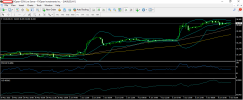
Gold prices edge up as US inflation eases
Yesterday, gold prices drew a small-bodied bullish candle with shadows on the top and bottom of the candle. Prices formed a high of 3265, a low of 3216, and a close of 3249. Gold prices are near the lower band, which was a support level in early May.
A weaker-than-expected US inflation report and a trade tariff deal between China and the US could keep gold prices below the $3,300 level. The Bureau of Labor Statistics reported that the Consumer Price Index for All Urban Consumers (CPI-U) increased 0.2 percent on a seasonally adjusted basis in April, after falling 0.1 percent in March in the US. Over the past 12 months, the all-goods index has increased by 2.3 percent before seasonal adjustments.
The Fed is expected to remain cautious despite falling inflation, with analysts warning that inflation could rise as tariffs gradually push up prices. According to the CME Group’s Fedwatch tool, the probability of the Fed keeping rates unchanged at its June 18 Fed meeting is 91.8%, and the probability of a 25 basis point cut is only 8.2%.
Recent US-China trade tariff talks that have reached some points of agreement have increased risk appetite and sent bullion prices lower. However, geopolitical risks and the latest developments in tariff policy could push gold in either direction.
Meanwhile, the World Gold Council reports that China added 2 tonnes to its gold reserves in April. The National Bank of Poland increased by 12 tonnes in April to 509 tonnes, while the Czech National Bank increased its reserves by 2.5 tonnes in April. The adoption of gold by central banks could maintain the value of gold in the long term.
This week, analysts will look to the US PPI data to be released on Thursday, which could be a trigger for the USD value, which is often negatively correlated to gold.




















